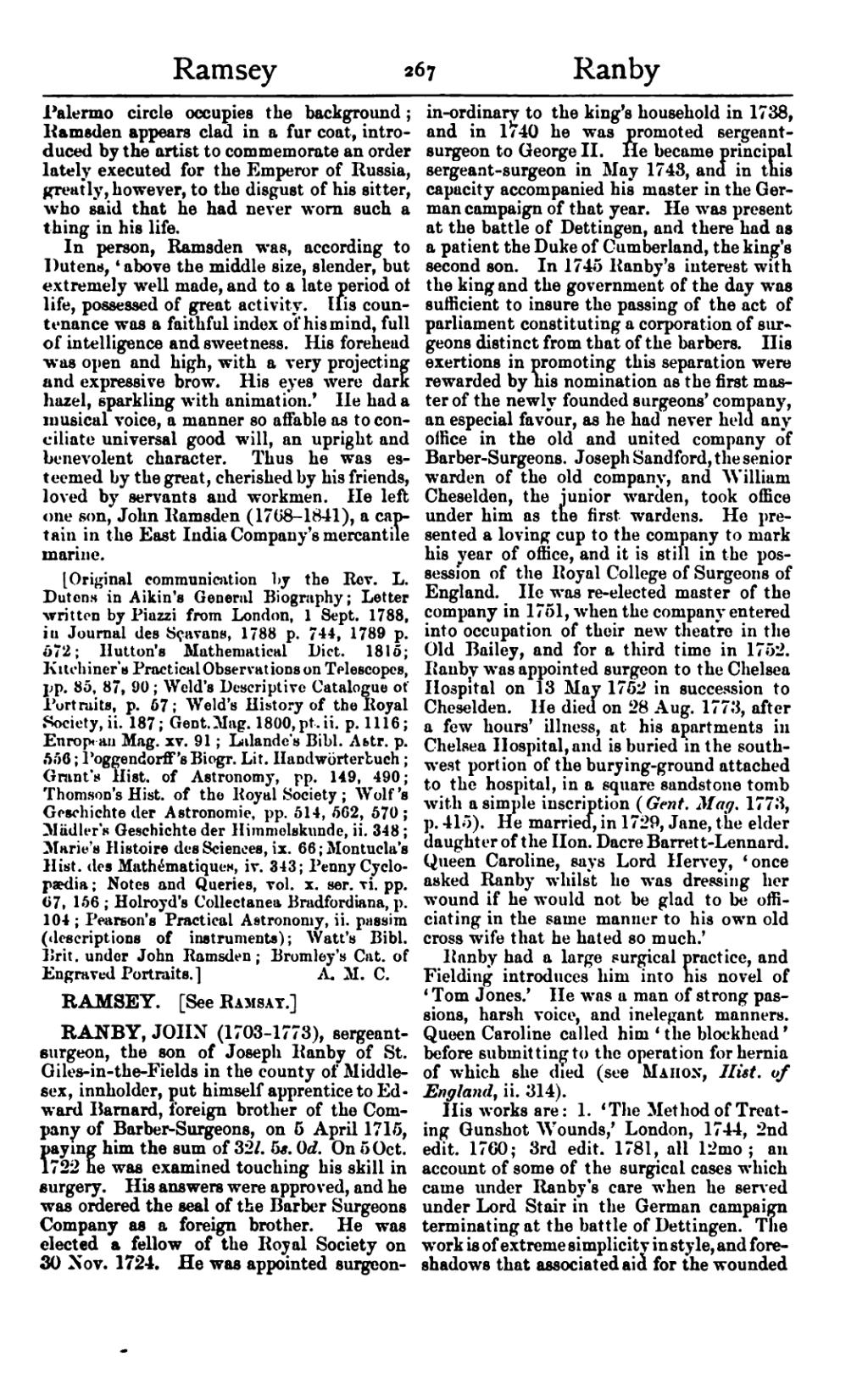Palermo circle occupies the background; Ramsden appears clad in a fur coat, introduced by the artist to commemorate an order lately executed for the Emperor of Russia, greatly, however, to the disgust of his sitter, who said that he had never worn such a thing in his life. In person, Ramsden was, according to Dutens, ‘above the middle size, slender, but extremely well made, and to a late period of life, possessed of great activity. His countenance was a faithful index of his mind, full of intelligence and sweetness. His forehead was open and high, with a very projecting and expressive brow. His eyes were dark hazel, sparkling with animation.’ He had a musical voice, a manner so affable as to conciliate universal good will, an upright and benevolent character. He left one son, John Ramsden (1768–1841), a captain in the East India Company's mercantile marine.
[Original communication by the Rev. L. Dutens in Aikin's General Biography; Letter written by Piazzi from London, 1 Sept. 1788, in Journal des Sçavans, 1788 p. 744, 1789 p. 572; Hutton's Mathematical Dict. 1815; Kitchiner's Practical Observations on Telescopes, pp. 85, 87, 90; Weld's Descriptive Catalogue of Portraits, p. 57; Weld's History of the Royal Society, ii. 187; Gent. Mag. 1800, pt. ii. p. 1116; European Mag. xv. 91; Lalande's Bibl. Astr. p. 556; Poggendorff's Biogr. Lit. Handwörterbuch; Grant's Hist. of Astronomy, pp. 149, 490; Thomson's Hist. of the Royal Society; Wolf's Geschichte der Astronomie, pp. 514, 562, 570; Mädler's Geschichte der Himmelskunde, ii. 348; Marie's Histoire des Sciences, ix. 66; Montucla's Hist. des Mathématiques, iv. 343; Penny Cyclopædia; Notes and Queries, vol. x. ser. vi. pp. 67, 156; Holroyd's Collectanea Bradfordiana, p. 104; Pearson's Practical Astronomy, ii. passim (descriptions of instruments); Watt's Bibl. Brit. under John Ramsden; Bromley's Cat. of Engraved Portraits.]
RAMSEY. [See Ramsay.]
RANBY, JOHN (1703–1773), sergeant-surgeon, the son of Joseph Ranby of St. Giles-in-the-Fields in the county of Middlesex, innholder, put himself apprentice to Edward Barnard, foreign brother of the Company of Barber-Surgeons, on 5 April 1715, paying him the sum of 32l. 5s. 0d. On 5 Oct. 1722 he was examined touching his skill in surgery. His answers were approved, and he was ordered the seal of the Barber Surgeons Company as a foreign brother. He was elected a fellow of the Royal Society on 30 Nov. 1724. He was appointed surgeon-in-ordinary to the king's household in 1738, and in 1740 he was promoted sergeant-surgeon to George II. He became principal sergeant-surgeon in May 1743, and in this capacity accompanied his master in the German campaign of that year. He was present at the battle of Dettingen, and there had as a patient the Duke of Cumberland, the king's second son. In 1745 Ranby's interest with the king and the government of the day was sufficient to insure the passing of the act of parliament constituting a corporation of surgeons distinct from that of the barbers. His exertions in promoting this separation were rewarded by his nomination as the first master of the newly founded surgeons' company, an especial favour, as he had never held any office in the old and united company of Barber-Surgeons. Joseph Sandford, the senior warden of the old company, and William Cheselden, the junior warden, took office under him as the first wardens. He presented a loving cup to the company to mark his year of office, and it is still in the possession of the Royal College of Surgeons of England. He was re-elected master of the company in 1751, when the company entered into occupation of their new theatre in the Old Bailey, and for a third time in 1752. Ranby was appointed surgeon to the Chelsea Hospital on 13 May 1752 in succession to Cheselden. He died on 28 Aug. 1773, after a few hours' illness, at his apartments in Chelsea Hospital, and is buried in the south-west portion of the burying-ground attached to the hospital, in a square sandstone tomb with a simple inscription (Gent. Mag. 1773, p. 415). He married, in 1729, Jane, the elder daughter of the Hon. Dacre Barrett-Lennard. Queen Caroline, says Lord Hervey, ‘once asked Ranby whilst he was dressing her wound if he would not be glad to be officiating in the same manner to his own old cross wife that he hated so much.’
Ranby had a large surgical practice, and Fielding introduces him into his novel of ‘Tom Jones.’ He was a man of strong passions, harsh voice, and inelegant manners. Queen Caroline called him ‘the blockhead’ before submitting to the operation for hernia of which she died (see Mahon, Hist. of England, ii. 314).
His works are: 1. ‘The Method of Treating Gunshot Wounds,’ London, 1744, 2nd edit. 1760; 3rd edit. 1781, all 12mo; an account of some of the surgical cases which came under Ranby's care when he served under Lord Stair in the German campaign terminating at the battle of Dettingen. The work is of extreme simplicity in style, and foreshadows that associated aid for the wounded
